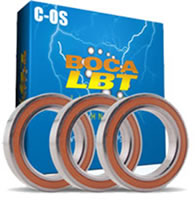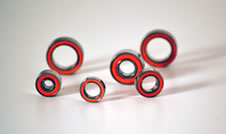Ceramic bearings, are they worth the extra cost?
Holder, J. (2012, January 02)
 I’ve had many people ask if ceramic bearings are really worth the extra cost when it comes to fishing reels? In this article we are going to help answer that question for you and explain exactly why and when is it best to use ceramic bearings or steel bearings.
I’ve had many people ask if ceramic bearings are really worth the extra cost when it comes to fishing reels? In this article we are going to help answer that question for you and explain exactly why and when is it best to use ceramic bearings or steel bearings.
Ceramic balls can be used to replace steel in ball bearings. Their higher hardness means they are much less susceptible to wear and can offer more than triple lifetimes. They also deform less under load, meaning they have less contact with the bearing retainer walls and can roll faster. In very high speed applications, heat from friction during rolling can cause problems for metal bearings, which are reduced by the use of ceramics. Ceramics are also more chemically resistant and can be used in wet environments where steel bearings would rust. In some cases, their electricity-insulating properties may also be valuable in bearings. The two major drawbacks to using ceramics are a significantly higher cost and susceptibility to damage under shock loads.
Because ceramic is a glass like surface it has an extremely low coefficient of friction and is ideal for applications seeking to reduce friction. Ceramic balls require less lubricant and have a greater hardness than steel balls which will contribute to increased bearing life. Thermal properties are better than steel balls resulting in less heat generation at high speeds.
There are two different main flavors when it comes to ceramic bearings, there are full-ceramic and hybrid ceramic bearings. Full ceramic bearings can continue to operate under extremely high temperatures and are capable of operating up to 1800 Deg. F. Ceramic is much lighter than steel and many bearings are 1/3 the weight of a comparable steel bearing. Full ceramic bearings are highly corrosion resistant and will stand up to most common acids, they will not corrode in exposure to freshwater or salt water. And finally full ceramic bearings are non-conductive.
Ceramic hybrid ball bearings use ceramic balls. Ceramic balls weigh up to 60% less than steel balls, depending on size. This reduces centrifugal loading and skidding, so hybrid ceramic bearings can operate up to 50% faster than conventional bearings. This means that the outer race groove exerts less force inward against the ball as the bearing spins. This reduction in force reduces the friction and rolling resistance. The lighter ball allows the bearing to spin faster, and uses less energy to maintain its speed. Ceramic hybrid ball bearings use these ceramic balls in place of steel balls. They are constructed with steel inner and outer rings, but ceramic balls so they are known as hybrids.
As you may know, there are no true waterproof seals for bearings, which is why eventually steel bearings will rust when used in fishing reels that are subjected to water, and what fishing reel isn’t? This is one of the important reasons for using ceramic bearings in fishing reels, preferably full-ceramic bearings. However, there is always an exception to every rule, and that rule is excessive shock load. Ceramic bearings are not good at handling excessive shock loads, which is why i would not recommend using them in any reel where you are say fighting a 400LB Pacific Tuna, in this case steel bearings would be best, although more maintenance and periodic replacement should be done on all steel bearings that are subjected to freshwater or saltwater.
The other great thing about full ceramic bearings is they are run completely dry, requiring no lubrication and can be cleaned with simple fresh clean water. Dry bearings can be a little more noisy than you might be use to so adding a drop of oil on each bearing will not hurt and will help quieten the bearings.
So you’ve had a little bearing 101 and understand the differences between ceramic and steel bearings and what applications are best for each. I have personally been using ceramic bearings in all my fishing reels since they first appeared on the market to anglers. Boca Bearings is considered the leader in bearing technology within many industries including angling. I have been using their Orange Seal Ceramic Bearings for many years in several different brands as well as models and not surprising they outlast every other manufacturers bearings on the market today.
The other important factor for all anglers, is casting distance. Ceramic bearings give you that extra edge that you need when distance means getting you bait in the right position. In field testing we experienced approximately a 19% increase in casting distance using the Orange Seal Dry Lube Bearings over traditional steel bearings. On a 30’ cast this translates into almost an additional 6’ of casting distance, for a total of 36’. That’s quite impressive from a simple yet very effective bearing upgrade.
Boca Bearings carries bearings for an impressive list of manufacturers including;
ABU GARCIA, ACCURATE, ADCOCK, ARDENT, AVET, BASS PRO, DAIWA, DUEL REEL, FIN NOR, G.LOOMIS, ISLANDER, JOHN MILNER, KINGPIN, KVD, LEW'S, LOOMIS, LOU'S, MITCHELL, NEWELL, OKUMA, PENN, PFLUEGER, PINNACLE, PRO GEAR, QUANTUM, RAVEN, ROSS FLOW, RYOBI, SHAKESPEARE, SHIMANO, SHINA, SILSTAR, TIBURON ENGINEERING, TOURNAMENT DRIFTER, and ZEBCO
 Boca Bearing Orange Seal
Boca Bearing Orange Seal
You will find arguments both ways as to whether ceramic bearings are really worth the extra cost, and do they provide any perceptible difference in action. Engineers on both sides do agree that ceramic bearings provide an advantage over steel counterparts when it comes to performance however they do not agree on what that extra percentage is.
For the angler the biggest advantage may be that ceramic does not rust. This means far less maintenance and cost savings overall in replacements over the years. Ceramic bearings simply make sense for any equipment subjected to water.
Ceramic bearings have been shown to have 1/10th the friction found in steel bearings, and they are 60% lighter than steel bearings. Understand that there are different grades of Silicon Nitrate Ceramic balls available on the market. Differences include impact resistance, roundness, surface finish and wear resistance. The highest quality bearings are Grade 5 (the very best), then you have grades 25, 50 and 100 which are more suitable for less demanding applications.
Ceramic is extremely hard, only diamond is harder, this hardness makes the cermamic balls impervious to scratches, unlike steel balls. Scratches cause friction, and friction causes loss of performance and lessens the overall lifetime of a bearing. So which do you think will last you longer, ceramic or steel balls? Ceramic of course!
If you want your fishing reels to last longer, cast smoother and farther, and stop bearing rust, then you should always upgrade to Ceramic Bearings in all your reels!
Source :
Holder, J. (2012, January 02). Ceramic bearings, are they worth the extra cost?. Retrieved from http://www.outdoorangling.com/articles/reviews/42-ceramic-bearings
